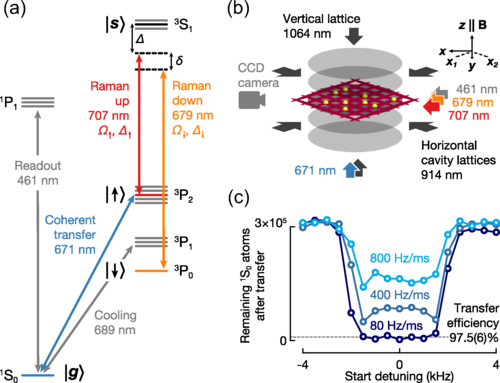The FineStructure Qubit, a quantum bit encoded in the metastable states of neutral strontium atoms, offers potential for fast quantum information processors and highly-tunable quantum simulators. The qubit demonstrates Rabi oscillations with over 60 coherent cycles and single-qubit rotations on a microsecond scale. Despite challenges such as sensitivity to atomic motion and laser phase noise, the FineStructure Qubit could unlock new functionalities like optical qutrits and mid-circuit readout operations. This development could significantly enhance the capabilities of quantum computing and quantum simulation technologies.
What is the FineStructure Qubit Encoded in Metastable Strontium Trapped in an Optical Lattice?
The FineStructure Qubit is a quantum bit encoded in the metastable states of neutral strontium atoms. This qubit is controlled coherently and is coupled by a Raman transition. The qubit is initialized using a magnetic quadrupole transition, demonstrating coherent state initialization. The qubit shows Rabi oscillations with more than 60 coherent cycles and single-qubit rotations on the microsecond scale. With spin echo, coherence times of tens of milliseconds are demonstrated. These results pave the way for fast quantum information processors and highly-tunable quantum simulators with two-electron atoms.
Neutral atoms are a promising platform for quantum computing and quantum simulation due to their long coherence times and highly scalable architecture. Two-electron atoms, in particular, have gained increasing attention as their rich level structure offers multiple opportunities to encode high-quality qubits. Coupling a ground and a metastable state via an optical clock transition has enabled the observation of exceptionally long coherence times and direct access to Rydberg states.
However, relying on an ultra-narrow optical transition limits operating speed and poses challenges due to an inherent sensitivity to atomic motion and laser phase noise. Faster and more robust qubit rotations can be achieved by coupling two states with a lower energy splitting using a coherent Raman transition. Such a coupling scheme has been successfully implemented between nuclear spin states in fermionic isotopes of Yb and Sr.
How is the FineStructure Qubit Encoded?
The FineStructure Qubit is encoded in the metastable states of neutral strontium atoms. These states are coupled via a two-photon Raman transition through the triplet state. Fast two-photon Rabi oscillations with frequencies up to 2π400kHz are demonstrated, and their decoherence mechanisms are studied. Proof-of-principle readout methods with about 96% detection efficiency that can be used for mid-circuit readout are shown. The coherence of the fine-structure qubit is investigated with Ramsey and spin-echo measurements.
The experimental setup involves loading about 10^8 88Sr atoms into a 3D optical lattice. In the horizontal direction, the atoms are trapped using laser light with a wavelength of 914 nm, which forms an optical lattice inside an enhancement cavity. A retroreflected laser beam at 1064 nm generates the vertical lattice. After loading the atoms into the lattice, resolved sideband cooling is performed on the 1S0-3P1 transition at a horizontal-vertical lattice depth of 150Erec-270Erec.
What are the Advantages of the FineStructure Qubit?
The FineStructure Qubit offers several advantages for quantum computing and quantum simulation. Its natural frequency splitting on the terahertz scale, although challenging to achieve state-insensitive trapping conditions, can be advantageous for state preparation and readout as energy selectivity rather than polarization selectivity can be leveraged. In combination with the existing optical and nuclear qubits, this novel fine-structure qubit can unlock the full potential of the level scheme, leading to new functionalities such as optical qutrits, single-photon transition to Rydberg states with fast qubit rotations, and mid-circuit readout operations.
The FineStructure Qubit also demonstrates core capabilities using Sr atoms trapped in an optical lattice. Fast two-photon Rabi oscillations with frequencies up to 2π400kHz are demonstrated, and their decoherence mechanisms are studied. Proof-of-principle readout methods with about 96% detection efficiency that can be used for mid-circuit readout are shown. The coherence of the fine-structure qubit is investigated with Ramsey and spin-echo measurements.
What is the Future of the FineStructure Qubit?
The results of the study on the FineStructure Qubit pave the way for fast quantum information processors and highly-tunable quantum simulators with two-electron atoms. The qubit shows Rabi oscillations with more than 60 coherent cycles and single-qubit rotations on the microsecond scale. With spin echo, coherence times of tens of milliseconds are demonstrated. These results suggest that the FineStructure Qubit could be a key component in the development of future quantum computing and quantum simulation technologies.
Moreover, the FineStructure Qubit could unlock the full potential of the level scheme, leading to new functionalities such as optical qutrits, single-photon transition to Rydberg states with fast qubit rotations, and mid-circuit readout operations. These new functionalities could further expand the capabilities of quantum computing and quantum simulation technologies, making them more powerful and versatile.
What are the Challenges in Implementing the FineStructure Qubit?
While the FineStructure Qubit offers several advantages, there are also challenges in its implementation. The natural frequency splitting on the terahertz scale, although advantageous for state preparation and readout, makes it more challenging to achieve state-insensitive trapping conditions. This could limit the practical application of the FineStructure Qubit in certain quantum computing and quantum simulation scenarios.
Moreover, the reliance on an ultra-narrow optical transition limits operating speed and poses challenges due to an inherent sensitivity to atomic motion and laser phase noise. These challenges need to be addressed to fully realize the potential of the FineStructure Qubit in quantum computing and quantum simulation technologies. Despite these challenges, the FineStructure Qubit represents a promising development in the field of quantum computing and quantum simulation, and further research and development could help overcome these challenges.
Publication details: “Fine-Structure Qubit Encoded in Metastable Strontium Trapped in an Optical Lattice”
Publication Date: 2024-04-11
Authors: Sebastian Pucher, V. Klüsener, F. Spriestersbach, J. Geiger, et al.
Source: Physical review letters
DOI: https://doi.org/10.1103/physrevlett.132.150605

